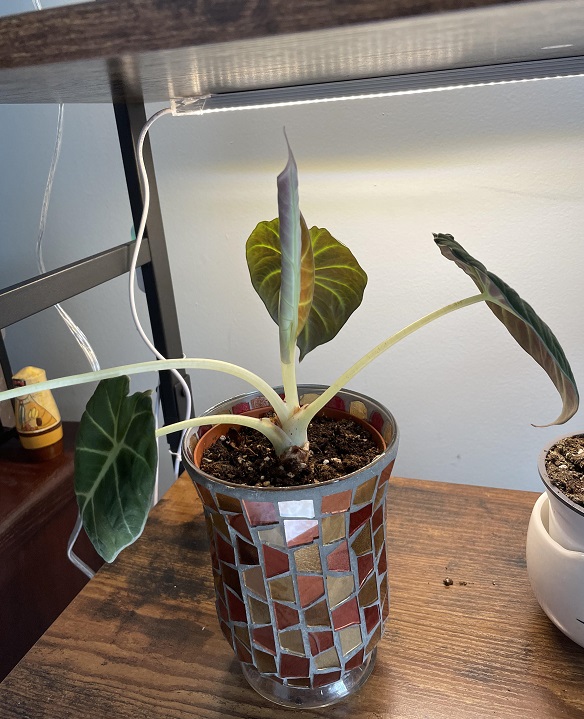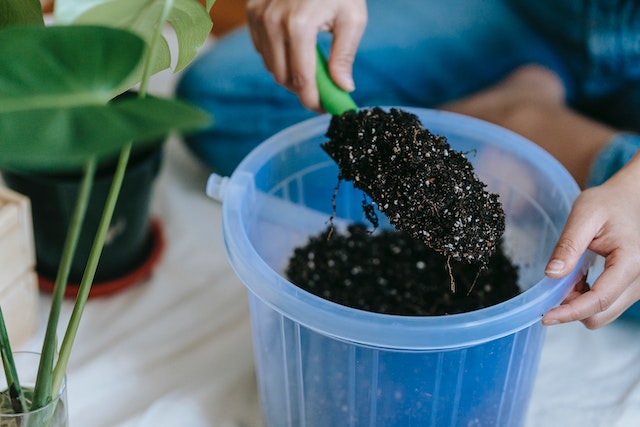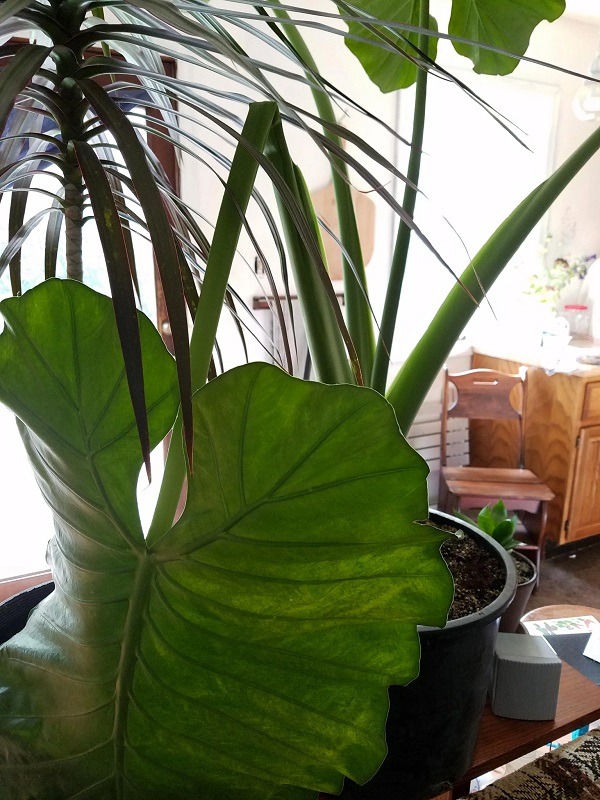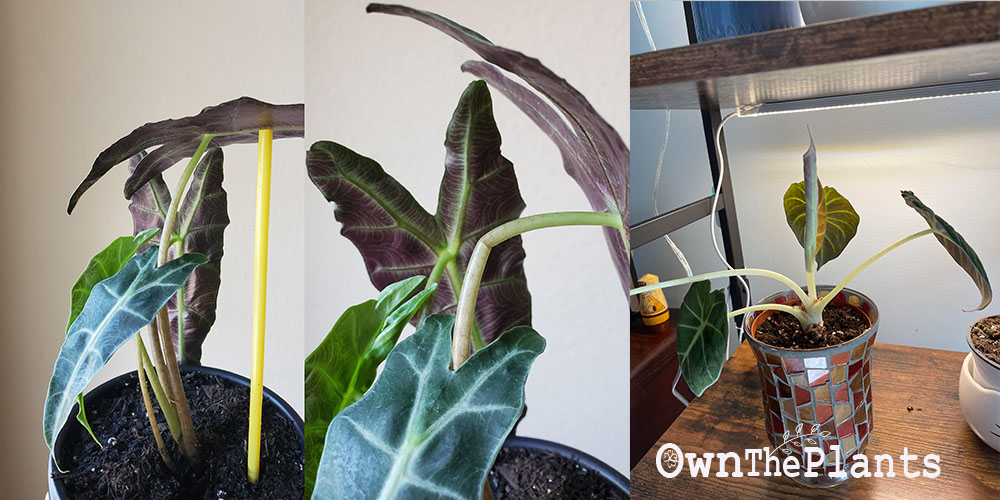Alocasias are one of the most popular houseplants in the world due to its lovely, distinct foliage and generally easy-to-care maintenance.
Their beauty lies on their unique leaves and patterned stems, which are available in many shapes and colors, depending on the species or variety.
However, there could be times that you can see these stems bend and droop toward the ground. Several reasons can cause this problem, and you need to get to the bottom of this to correctly provide fixing measures, as different causes have different fixes.
In this article, we will guide you in finding out the possible reasons behind the bending stems of your Alocasia.
We will also give you the steps on how you can solve this problem and bring back your droopy Alocasia back to its upright stature.
What are you waiting for? Let’s dive right in.
Why Are My Alocasia Stems Bending?
Any problem on your plant’s growing habit could only mean one thing: It is not getting the right care or environmental conditions to thrive healthily. It is an apparent sign that something is wrong with your Alocasia.
The bending of stems by your Alocasia can be due to various reasons. It could be due to environmental factors such as light and water.
It can also be due to pest infestations, and other man-made misdoings like choosing an incorrect pot size, fertilization problems, and physical damage.
Let’s discuss these reasons one-by-one for you to fully understand your plant’s problem.
Insufficient Water
Remember that as a tropical plant, your Alocasias thrive best in slight moist growing medium and has a low tolerance to dry soil.
If you usually forget to water your plants, it is not a curious case for you to observe bending stems.
Water, not just helps in the metabolic functions of plants such as photosynthesis and respiration, but also it helps keep the plant’s upright stature.
Without sufficient water, your Alocasia will not hold up and thus will bend toward the ground.
How Do I Give Sufficient Water To My Alocasia?
Check first the soil and confirm if your plant needs watering. If the soil is moist, then underwatering is not the cause.
If the soil is dry and cracky, consider insufficient water as a cause. Water it at once, but not aggressively. Do not let the soil get waterlogged.
Follow these steps to ensure that this problem will not happen again:
- Keep a reminder to water your Alocasia every after a few days.
- Water only when the soil is dry. If the soil is still moist, skip watering until the next day.
- Plow soil or poke with a stick to aerate it. This helps the plant to absorb water.
- Use a self-watering kit if you will be away from the house for long.
- Ensure that the soil is well-draining but can hold moisture.
Overwatering
Although your plant loves a moist environment, it cannot be left to soak for too long.
When you water blindly without checking if your plant needs water or not, the tendency is for your Alocasia to get overwatered. It causes many problems, including root rot and bending stems.
When the soil is waterlogged, it becomes soggy and compacted and the roots will suffocate due to excessive water and lack of oxygen. The roots cannot absorb the nutrients and water well, thus weakening your lovely plant.
How Do I Fix My Overwatered Alocasia?
Immediately stop watering and allow the soil to dry up first. Tilt your pot to get rid of standing water.
Leave your Alocasia under a bright location with indirect light to help hasten the drying of the soil. Resume watering only when the soil is dry.
Overwatering is often hand-in-hand with root rot. Check your plant for mushy and brown roots and prune them. Consider spraying a fungicide on the healthy ones to avoid diseases caused by extremely moist conditions.
Follow these steps to ensure you will not encounter this problem again:
- Rectify your watering routine. Check the soil first before watering. If the soil is still moist, skip watering.
- Place your plant under bright, indirect light to allow water to evaporate.
- Use a light, airy, and well-draining soil mix. You can add organic materials such as coco coir, peat moss, pumice, and others to help aerate the soil.
Low Light Conditions

Plants cannot thrive without light, as it is their main source of food.
They cannot efficiently make their own food, known as photosynthesis, and perform other functions if the light is not sufficient. Naturally, this will weaken your plant, causing it to bend and wilt.
How Do I Provide Sufficient Light To My Alocasia?
Locate the best spot for your Alocasia, whether it be indoors or outdoors.
Just keep in mind that your plant will thrive best under bright, indirect lighting. Avoid direct sunlight for a very long time since it will cause foliage problems to your plants.
Here are some other tips and reminders for the light requirements of your Alocasia:
- A 6-8 hours of bright indirect lighting is the optimum for your plant.
- Use artificial light if natural light is not sufficient indoors. Place your plant a few steps away from the source to avoid direct hit of light.
- During winter season, allow your plant to get direct sunlight in the morning for two to three hours daily.
Direct Sunlight
Exposure to direct sunlight for a long period is a no-no for Alocasias. They are not adapted to withstand extreme light conditions, as they natively grow in dappled light in rainforests.
When grown in a direct sunlight environment, the defense mechanism of your Alocasia is to bend away as much as possible from the sun.
How Do You Fix An Exposed Alocasia To Direct Sunlight?
Just like the previous fix, locate a better place for your Alocasia, where there will be enough indirect light.
When grown indoors, do not place it directly near the window or an artificial light to save it from direct light exposure. Place sheer curtains or blinds to filter light.
Furthermore, when your Alocasia is grown outdoors, move it to a shadier part where it will only get direct sunlight for a few hours and mostly filtered light throughout the day.
Pest Problems
Pest infestations are very serious problem to all plants, as they feed on plant juices containing all the necessary nutrients for plants.
They deplete the nutrients so the plants become weak and cannot sustain themselves. One manifestation of this problem is bending stems.
Alocasias are somehow pests magnets. Some common pests include aphids, mealybugs, and scales. These pests multiply aggressively in moist and low-light conditions.
How Do You Treat Pest Infestations On Your Alocasia?
Immediately isolate your Alocasia so that you can stop the spread of pests to other plants.
Check the other plants nearby for signs of pest infestation. Prune the infested parts and spray with insecticides, pesticides, or horticultural oils such as neem oils.
To prevent this problem from ever happening again, consider these steps:
- Always provide suitable environmental conditions for your plant. Low light conditions and extremely moist environment, not just harms your plant, but also allows pests to thrive.
- Spray insecticides or pesticides once a month. You can also use Neem oil if you opt for a more organic substance.
Incorrect Pot Size
Of course, as your plant grows larger, its roots grow extensively too, filling its pot with time. Thus, with time, your plant gets rootbound, meaning the pot could no longer hold the size of the plant.
When this happens, the roots become too compact that it could not freely breathe and absorb nutrients and water efficiently.
Without sufficient water and nutrients, the plant weakens. This can also be the reason why your Alocasia plant is bending.
How Do You Repot A Rootbound Alocasia?

Any rootbound plant should be repotted immediately. Remember to always choose the right size of the pot as an extremely large pot has a high tendency to get overwatered.
As a general rule, choose a pot that is two inches larger than the previous pot.
Some tips you must consider when repotting:
- You can reuse the previous medium or make a fresh one. Remember that Alocasias thrive in airy, well-draining soil, so make a mixture with organic materials such as coco coir, peat moss, or pumice.
- Water the soil a day before you decide to repot your Alocasia.
- Always be careful when you take the Alocasia out of its old pot and when you loosen crowded root system.
- Tap the pot on the sides to settle the plant down.
Nutrient Deficiency
Plants require nutrients to grow healthily. Remember that plants that are grown in pots do not get nutrients naturally, hence, it is essential to feed your plants with fertilizer at least once a month.
As soil loses nutrients every watering, the plants also get weaker, producing unhealthy and deformed stems and leaves.
How Do You Give Enough Fertilizer to Your Alocasia?
Feed your Alocasias once a month. Your Alocasia plant requires more nutrients since it is a large plant that grows large leaves.
Consider these steps to be able to maximize the feeding of your Alocasia:
- Feed your plant with balanced NPK fertilizer (20:20:20).
- Fertilize during the growth season, usually spring and summer.
- Lessen feeding during the winter season when your plant undergoes dormancy.
Overfertilization
In gardening, sometimes less is better. An overtilized Alocasia can manifests deformation of the whole plant and discoloration of leaves.
This is because too much fertilizer causes chemical burns to the roots.
How Do You Treat Your Overfertilized Alocasia?
Scrape the topsoil to get rid of the excess fertilizer build-up. Flush them down by watering your Alocasia in the sink 3-4 times, until the excess salts leach out.
Repot your Alocasia with a fresh potting medium, and dilute the fertilizer in your succeeding fertilization schedule.
Physical Damage

No plant owner is perfect, and sometimes we personally, but not intentionally hurt our plants. If you accidentally hit your Alocasia or if it is put in an unstable, high place and falls off, the stems can break and bend due to damage.
How Do You Fix The Bent Stems Of Your Alocasia?
To fix a bent Alocasia caused by physical damage, support the stem by attaching a stick to it.
Allow your plant to recover and heal. While doing so, relocate your plant in a spot where it is away and safe from getting future accidents.
Final Thoughts
A lot of people share the common problem of bending Alocasias. This is because they are sensitive to adverse environmental conditions, which can potentially lead to death if not taken care of immediately. Although they are very popular houseplants, they can be a bit fussy and difficult to maintain.
Fixing your bent Alocasia is easy once you get the real cause behind it. So observe and check your plant thoroughly, before doing your next move.
Otherwise, your efforts will be futile and your plant will just get worse.
If you have something to share about your Alocasias, feel free to drop anything at the comment section below.
Let us hear about your Alocasia journey!
Images credits: Shirobelle, Efficient_Bicycle_86/ Reddits
